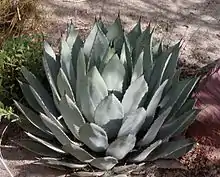Agave palmeri
Agave palmeri (also known as Palmer's century plant) is an especially large member of the genus Agave, in the family Asparagaceae. It is native to southern Arizona, southwestern New Mexico, Sonora and Chihuahua.[1][2][3] The plant is also frequently cultivated as an ornamental in other regions.[4]
| Agave palmeri | |
|---|---|
 | |
| Agave palmeri at Desert Demonstration Garden in Las Vegas | |
| Scientific classification | |
| Kingdom: | Plantae |
| Clade: | Tracheophytes |
| Clade: | Angiosperms |
| Clade: | Monocots |
| Order: | Asparagales |
| Family: | Asparagaceae |
| Subfamily: | Agavoideae |
| Genus: | Agave |
| Species: | A. palmeri |
| Binomial name | |
| Agave palmeri | |
Description
Agave palmeri is the largest Agave species growing in the United States. It produces a basal leaf rosette of fleshy, upright green leaves of up to 120 cm (4 ft) in length, with jagged edges and ending in thick spines of 3–6 cm (1.2–2.4 inches) long. Flowers are pale yellow and green and 1.6–2 inches long and grow on branches in the upper third of the flower spike, which can be between up to 5 m (16.5 feet) tall.[2][5][6]
Cultivation
The plant requires a large pot but is very tolerant of a wide range of conditions, including temperatures of around –10 °C.[7]
References
- Engelmann, Georg. Transactions of the Academy of Science of St. Louis 3: 319–320. 1875.
- Gentry, Howard Scott. Agaves of Continental North America. University of Arizona Press, Tucson, 1992.
- CONABIO. 2009. Catálogo taxonómico de especies de México. 1. In Capital Nat. México. CONABIO, Mexico D.F..
- Bailey, L.H. & E.Z. Bailey. 1976. Hortus Third i–xiv, 1–1290. MacMillan, New York.
- Flora of North America, Agave palmeri, v 26 p 460.
- Shreve, F. & I. L. Wiggins. 1964. Vegetation and Flora of the Sonoran Desert 2 vols. Stanford University Press, Stanford.
- Complete Encyclopedia of Succulents by Zdenek Jezek and Libor Kunte
| Wikimedia Commons has media related to Agave palmeri. |